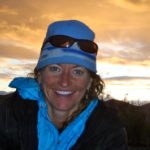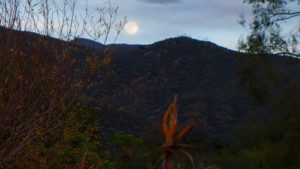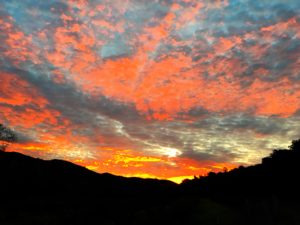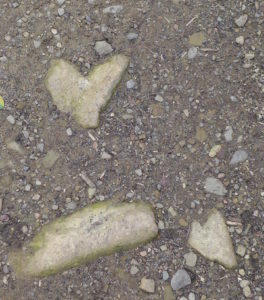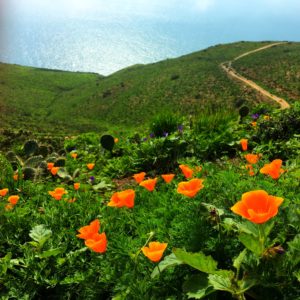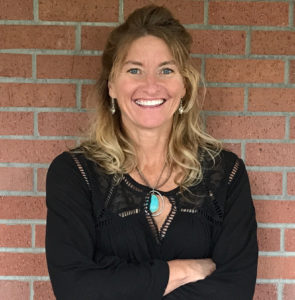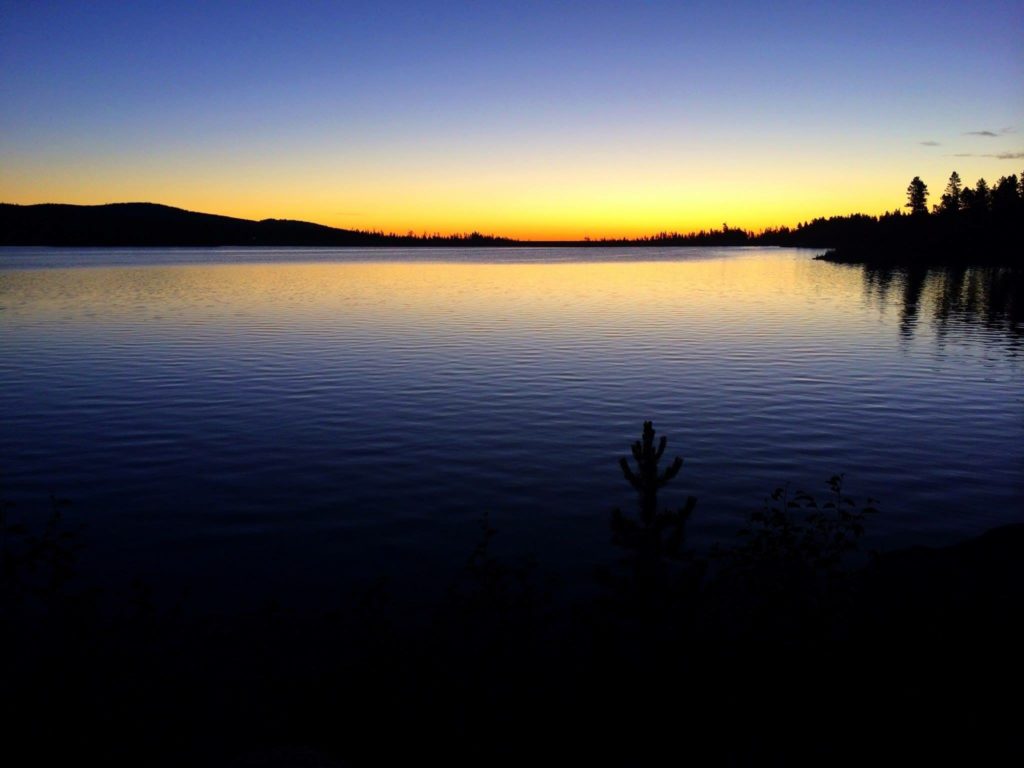Dear iPhone & Facebook:
I Love You Too Much
February 27th, 2017
Hi. My name is Shelli Johnson, and I love my iPhone and Facebook too much.
Sometimes I long for a “bag phone.” Do you remember those? I think they came out in 1993, and they worked terribly. They were not compact and did not have a beautiful design. They were so big and bulky that they took up almost the entire front passenger seat of the car, and were not very reliable. On a good day, you might be able to successfully make a phone call. Having one made you feel like you had a method of communication in case of an emergency, but that was the extent of a bag phone’s value.
I just returned from a Byron Katie workshop and Silent Retreat. For 5 days in Ojai, CA, I didn’t say a single word, despite being amidst 115 other people and living in a community. As part of the Silence, I had no use of my iPhone or social media, and had no contact with family or friends. (I also semi-fasted, and was in a “hungry” state.)
While I was very eager to see Byron Katie in action, and to learn from her, and from my experience in Silence, it was the “no connectivity to devices” that I was most yearning for.
Unlike the bag phones of yesterday, today’s “smartphones” are beautifully-designed devices that not only work in emergencies, but provide all of my social networking, camera, audio books, music, shopping, level of physical activity, navigation, movies, not to mention a number of ways to communicate with people all over the world, with ease and immediacy.
Before I get to the shortcomings, which, by the way, are my shortcomings, not the iPhone’s or Facebook’s, I want to emphasize all there is to love about my iPhone and Facebook. (Please bear with me and continue reading; I promise I’ve tried to make it worth your while, and you’ll even get to read about a “covered wagon holdup.”)
Thanks to Facebook, I can keep in touch with my sisters, brother, parents, my Grandma, aunts, in-laws, uncles and cousins. I have some amazing friends that I would not have come to meet without Facebook. And, I have enriched many of my existing friendships. You’re a good friend on Facebook the same way you’re a good friend in real life. You do not only talk (post). You are interested in your friends’ lives so you listen and take interest in what they share, too. Being a good friend takes time and effort, and friendships are among my life’s greatest of blessings. Most of my relatives, friends, and clients are not local, yet I can keep in touch with all of them regardless of where they live. I can share in their celebrations and see photos from their lives. I can learn about the things that interest or matter to them, and find out if they’re suffering or in need of help or support.
Word of mouth has always been the most valuable form of marketing, and social media is word of mouth on steroids.I have “met” many coaching, Epic Adventure, and keynote presenting clients thanks to Facebook. Many – most – of my Epic Women, and other adventure clients have discovered me by way of Facebook. I am blessed by these meaningful relationships, and the times we’ve shared on the trail. I wouldn’t have these relationships without Facebook.
I love that Facebook tells me when my friends are having birthdays. I love being introduced to books, movies, blog posts, podcasts, articles, music, poetry, comedians, bacon recipes, travel destinations and other things that inspire me that I would not have been made aware of had it not been for my friends on Facebook.
I love sharing. This is just part of who I am. From 1994-2008, when I was operating Yellowstone Journal and YellowstonePark.com, I used to write 100,000 words of original content every year, including stories about wolves, grizzly bears, geysers in Yellowstone, and about various adventures throughout the greater Yellowstone region. And while I loved reporting on and writing the stories, I loved sharing them even more. I’ve written and published 300 posts on my adventure blog because I love writing, and I love sharing. I’m a voracious reader, so I love sharing about books or anything that inspires me. Facebook, with just a click of a button, allows me a way to share all of these things, and more, with my friends, and their friends, and with the world.
My iPhone has a great camera and makes it easy for me to capture a great photo of a special moment, and with just a click, I can upload it to Facebook for sharing and “keeping.” Speaking of keeping, I have used Facebook as our family’s “life streaming” record and timeline since 2009. I value photos and memory-making moments. I love that a photo stops time and captures a moment. I can look back at a photo, and be transported back to that very moment and remember things about it that I otherwise wouldn’t remember if not for the photo. For me, these photos and videos are priceless. All of the major events and celebrations in my family’s life have been posted, and the result is we have these memories and milestones on record in a rich and chronological format that I wouldn’t have without Facebook.
I love my iPhone because I can be reliably reached by my family and friends, or in case of an emergency. I love the connection it enables with family and friends. Texting during travel to notify someone you’ve safely arrived to your destination, to line up a cab, check flights, etc. makes our iPhone invaluable. I experience great joy when I get texts and meaningful notes and “pings” from people who mean a lot to me. These short, unexpected messages can make my day. I love that my iPhone is a camera and a way for me to listen to music, audiobooks and podcasts. I love that my iPhone lets me share most of my stuff with family, friends, and Facebook.
It is also a fact that without the wonders of technology, I would not have the blessed life that I live today. It is not a stretch to say this. We started our first company, Yellowstone Journal Corporation, in 1994. We were operating out on the Frontier of Wyoming and with limited financial resources. It was a struggle to say the least. But then the internet arrived and we developed our first website, YellowstonePark.com, in 1995, and we could suddenly market Yellowstone’s wonders to, literally, the world. For the next 14 years we embraced the technology, innovating and expanding the company, before selling it in 2008 to Active Interest Media. Without technology, that story would have been a shorter and less successful one, and almost certainly would not have had that great ending, which enabled me to reinvent myself and create Epic Life in 2011. Without technology, I would not be able to do the work I do while living where I do. So technology is not the bad guy. Hardly.
The issue is I love Facebook and my iPhone too much. I already have quite a few boundaries in place. (I don’t have my cell phone when in the kitchen or at the table for dinner, anytime I’m with my family (unless taking photos of them, which can be excessive and I’m working on this), in the bedroom, during lunch or coffee dates, before kids are off to school, etc.) Still, I feel too tethered. For better or worse, I am self aware, and I know that I’m too tethered. It is a reality that I’m looking down, at my iPhone, too often, and that, as a result, I’m often missing out on what’s happening in the present moment. David Brooks, in a conversation with Krista Tippett and E. J. Dionne, mentioned the idea of “disordered loves.” That describes my relationship with my iPhone and Facebook – it’s a love, but it feels out of order…
The current (March 2017) edition of Prevention magazine includes a feature article about me, and it is about a depressive slump I experienced from 2006-2009, and how, among other things, I used hiking to get myself out of it. Part of that slump was the result of being too tethered to my devices when my sons were younger. Back then, my tethered-ness was mostly due to work demands. The point is, I know firsthand that tethered-ness to technology is a slippery slope for me, and I’m sensing trouble.
Management guru Peter Drucker once said something that I’m going to paraphrase: Tell me what your values are, and I might believe you. But show me your calendar (and use of time) and I’ll tell you what you really value. This resonates. I say I value experience and time with family and loved ones, first and foremost, more than my technology, but the truth is I feel my actions are often not measuring up, and it can be confusing since it’s often family and friends the devices are connecting me to.
Unfortunately, I’m not the only one with a problem. Just last year (2016), the business consultancy, Deloitte, found that Americans are looking at their phones more than 8 billion times a day. I think this works out to be a staggering, 150 times/day, on average. And, it’s not to answer a call or talk on the phone because research indicates that we only use our cell phones as phones about 10% of the time. The majority of our time on the phone is using social media, texting, watching videos, playing games, looking stuff up, Netflix binging, etc. Some 67% of Americans admit to checking their status updates in the middle of the night, during sex, and before attending to basic biological needs, like going to the bathroom, sleeping, or eating breakfast. (For the record, as tethered as I am, I am, thankfully, not in this 67%.)
I recently read a fantastic book, Stealing Fire: How Silicon Valley, the Navy SEALS, and Maverick Scientists are Revolutionizing The Way We Live and Work. The book is not about overusing Facebook. It’s about a revolution. Over the past decade, Silicon Valley executives like Eric Schmidt and Elon Musk, Special Operators like the Navy SEALs and the Green Berets, and maverick scientists like Sasha Shulgin and Amy Cuddy have turned everything we thought we knew about high performance upside down. Instead of grit, better habits, or 10,000 hours, these trailblazers have found a surprising short cut. They’re harnessing rare and controversial states of consciousness to solve critical challenges and outperform the competition. What does this have to do with loving the iPhone and Facebook too much, you ask? That is a great question and the answer is, Nothing.
However, there is an excerpt in it that is very relevant to this post. The book’s authors, Steven Kotler and Jamie Wheal, of the Flow Genome Project, report that the reason online distractions, particularly social media (Facebook, Twitter, Instagram, etc.), are so sticky is because effectively they prime our brains for reward, mainly the feel-good neurochemical, dopamine. Stanford neuroscientist Robert Sapolsky calls this priming “the magic of Maybe.” According to Kotler and Wheal: When we check our email or Facebook or Twitter and sometimes we find a response, and sometimes we don’t, the next time a friend connects, Sapolsky discovered that we enjoy a 400% spike in dopamine. Excuse my language, but holy crap. When we get a contact or like or love from a friend we enjoy a 400% spike/”reward” that is a rush of happiness and contentment. Perhaps it’s no wonder that social media and related distractions lead to tethered-ness that can eventually become an addiction. This research also raises the question: What is the emotional experience/cost when you get no response(s)?
And here we are back to my main reason for this long-form blog post: I am concerned that my tethered-ness, if I don’t make some changes, could turn into an addiction. Whew. I said it.
I arrived to Ojai, CA, checked into the Silent Retreat, and then eagerly addressed the powering off of my iPhone. (Note: Before powering off the iPhone, I did two significant things: First, I deleted my Facebook app, which was huge, since that’s one of the reasons my iPhone is so valuable to me and why I’m so tethered – the ease with which I can check in with my network of friends, and post and share stuff with them – and second, I turned off “Notifications” for my numerous apps. That way when I did “re-enter” and power on the device, I wouldn’t be immediately alerted, and sucked into the red circle with the probably-huge number of pending notifications on particular apps on my home screen.) Then, I powered off my iPhone, and tucked it deep into my suitcase, where I would not see it for 5 days.
As I did this, it felt like “help is on the way.” The last time I felt such important relief was when I went to a doctor in 2006, and said for the first time, out loud, that I was feeling depressed, and sinking deeper and deeper, and that I needed help. I left with a antidepressant prescription in my pocket and the feeling that help was on the way. I felt this relief not from the antidepressant prescription but rather from the fact that I had come clean – I had been honest with someone about my state. That’s sort of how I feel about my tethered-ness to my iPhone. To be clear, no one in my life is complaining about my iPhone and Facebook use. But I feel as if it’s becoming a problem. During the aforementioned depressive slump that lasted from 2006-2009, I was drinking wine on too many weeknights. It wasn’t a problem, but it could sure have become one. That’s how I am with my tethered-ness to my iPhone right now. I want to make some changes.
The 5-day “detox” would be a good start.
For the record, this wasn’t the first time I went technology-free. Two years ago, our family did an experiment where, for 7 days, we didn’t use any technology (no phones, television, computer –- no screens of any kind). Also, when I lead Epic Life adventures in the wilderness, or when I’m on a personal wilderness trip, they are “unplugged” experiences, and I’m disconnected from my devices. So I knew what it was like to be disconnected, and last week, in Ojai, CA, I was yearning for it.
Here’s what I noticed, gained and/or missed with no connectivity to my iPhone or Facebook:
There was a full moon on the first day of my no technology. I went to Meditation Mount, above Ojai, to meditate and take in both the sunset, and the full moon, which was rising over the mountains right as the sun was setting behind different mountains. I found comfort in knowing that I was looking at the same moon as my family and friends, and felt “connected” to them in a particularly meaningful way.
I love to capture photos of things that I see that are pretty, inspiring, peculiar or funny. Not having my iPhone –and being limited to my “regular” camera that has no connectivity or “sharing” ability – freed me up from quite a bit of capturing (and often sharing to Facebook or Instagram) that I would normally have done. I did take some photos of things I couldn’t resist capturing, but not very many, and as a result of my limited camera use, I think I actually saw more.
I thought about my family and friends even more than I normally would. Sure, it probably didn’t hurt that I was in Silence, and meditating and in contemplation often, but I found that without my tethered-ness to my iPhone and the resulting lack of “connection” to my loved ones, I thought about them more frequently than when I have in my pocket quick and easy potential connectivity to them.
I slept better. This could have had to do with the absence of Jerry’s snoring (haha), but I think it had more to do with my state of mind. My life was much simpler. Looking at our devices’ screens, and the blue light they emit, affects the production of the sleep hormone melatonin. This is bad news because melatonin is what signals to the body that we’re ready for sleep. Without use of technology, I fell to sleep more easily, and reached deeper sleep. I know I slept well because each night I very obviously reached the dream sleep stage. I had vivid dreams, including one where I was driving a covered wagon and got “held up” in front of the Farmer and the Cook shop and restaurant by a cowboy (someone I’d see in my home state of Wyoming), who wanted to take one of my wagon wheels. I was stressed out not being able to talk to him (due to the vow of Silence) so I was motioning with my finger, zipping it across my lips, etc., and he was so confused. The saga went on seemingly forever, before he just took one of my wheels and all I could do was use hand signals and frantically wave my arms to passersby trying to communicate the hold up/crime that had just occurred. Stressful during it, but hilarious upon waking up from it.
Another night I dreamt I wore my flannel pajamas to the workshop and couldn’t apologize for them and no one could say anything to me or tease me because of the Silence. A third dream I had was that I ran into a family from my hometown of Lander, WY, at the local market, and couldn’t talk to them and they were so confused that I wouldn’t respond to their questions, act exuberant, etc. The dream was not stressful, but humorous!
During the five days, the whites of my eyes were more white than I can ever remember them. Just that I’m noting the white of my eyes is noteworthy. It’s not like I’m always checking out how white the whites of my eyes are. I don’t even notice them normally. But they were noticeably white, clear of any bloodshot. I think this was because I didn’t look at any screens at all. I did not read any books – normally I read several times a day. Perhaps with the reduced eye strain from not reading and looking at screens made my eyes less red. Also, I had my eyes closed a lot as I spent a lot of time sitting in Silence, at the retreat, and during the day, and on my own time during the evenings and early mornings. So maybe the increased “resting time” of my eyes also helped.
I felt more vulnerable during my hikes. On 4 days, I got up and left to go hiking when it was still dark. I do this so that I can be on the trail when the sun rises. Normally I have a cell phone or my InReach just in case of an emergency. Jerry, or someone, always knows my whereabouts and my estimated schedule. Without my iPhone or InReach, I was hiking in an unfamiliar place, before first light and no one knew where I was or what I was doing. What this meant is I was more aware of people and my surroundings than normal. I was more vigilant.
I wanted to look up information (terms or words or people that were referenced in the workshop), and couldn’t use my iPhone to search Google or ask Siri for the quick answer or definition. (So, I wrote a list of things to look up later when I could. #oldschool)
I wanted to check the weather, and couldn’t. (I know, Woe is me… I realize as I write this these are such First World problems.)
I wondered about the news, but then quickly felt relief at my not having any of it.
Without my iPhone or the internet available, I felt more free to focus on one thing at a time, and, without my usual devices, it wasn’t nearly as difficult for me to do so. One of my three words for 2017 is One. I want to do one thing at a time. If I’m eating, I’m eating (not reading and eating). If I’m talking to Jerry or the boys, I’m only doing that; I’m not also on my laptop. If I’m folding laundry, I’m only folding laundry. The reason this is important to me is I want to do more deep and focused work, such as writing. I was incredibly focused during these five days with no technology or connectivity to my networks.
I thought of each of my coaching clients. Normally I check in on a pretty regular basis, usually via text, Facebook message or email. I was unable to do that and missed being able to offer my support, although I had informed them in advance of my temporary unavailability.
Despite that the average American adult reaches for his/her phone 150 times a day, and certainly I’m probably up there with the best of these users, I didn’t catch myself reaching, or looking for my iPhone. Normally I’m always checking my purse or my pocket for it when getting out of the car or leaving the house, etc. But I did this not once during the last five days. (This is encouraging for me because it suggests that if it’s out of sight, I won’t necessarily be looking for it to check it.)
Sherry Turkle, professor of the Social Studies of Science and Technology at the Massachusetts Institute of Technology, points out in her important book, Reclaiming Conversation, that if we have our cell phone on the table, or anywhere in sight, even if it’s powered off, the phone’s presence has a negative effect on the quality and depth of the conversation that will occur with the people who are together. So, you may want to keep your phone tucked away in your purse or briefcase, or leave it in the car when you go to a dinner party, or a business luncheon, at a round table, etc. – unless you want to limit the quality and depth of conversation to small talk and surface chatter.
Turkle’s books, including Reclaiming Conversation and Alone Together, ought to serve as cautionary tales. Turkle writes, “When children grow up with time alone with their thoughts, they feel a certain ground under their feet. Their imaginations bring them comfort. If children always have something outside of themselves to respond to, they don’t build up this resource. So it is not surprising that today’s young people become anxious if they are alone without a device. They are likely to say they are bored. From the youngest ages they have been diverted by structured play and the shiny objects of digital culture.”
Without my iPhone and connectivity, I wasn’t looking for that occasional and regular hit of dopamine/good vibes I get when I post something on Facebook and get likes and loves, and/or positive comments. As social animals, our human nature is to look to others for approval. I’ve worked hard to get to a place in my life where I don’t expend a lot of energy worrying about what others think. However, I am human, and networks like Facebook, with its acknowledgement mechanisms (likes and loves, etc.) makes it easy to get caught up in the social approval psychology – even if offline you do pretty well to not be concerned with it.
Joe Hollier is coming out with a product called the Light Phone, “your phone away from phone.” I will be glad to have one. The phone is a way to give people temporary breaks from their smart phones yet still enable particular people to reach you via phone call. It is brilliant. And ironic that some of us need technology’s help to disconnect from it. I remember Arianna Huffington suggesting this would be the case back in 2007 when we were at the Webby Awards to win an honor for YellowstonePark.com, and during her keynote she said as much. That was almost 10 years ago, and I remember not really believing what she predicted. But she was right. In addition to the Light Phone, there are numerous apps that lock you out of connectivity (Freedom app) for periods of time, apps (Moment) to measure how many times you reach for your phone, and how much time you’re spending looking at its screen, etc.
As Light Phone’s manifesto so aptly suggests, “Our phones have become our nervous habit, our invisible crutch. We love their illusion of productivity and stimulation that is socially acceptable to abuse. Multitasking is a myth, it is addictive and exhausting. It is glorified procrastination. When we consume so fast, there is no way for us to appreciate anything, and appreciation gives our lives meaning and purpose.” It goes further to suggest that we are so tethered to our iPhones that in today’s times, if you’re in a public place and you’re not staring down at your screen, but rather looking around – and God forbid – at people, some may think you’re a weirdo.
There were many times like this during my 5 days of Silence – while standing in line at a busy restaurant, or at a grocery store – and it was very noticeable that I didn’t have my iPhone to bail me out of the “just waiting” in line without something to occupy my attention. I didn’t mind so much as I love to connect with people and love opportunities for serendipity to happen, which are more likely to happen if not looking down at your phone screen, but most people who are tethered to their devices go a little crazy without them in these social situations when so many others are looking down at their phones.
I remember what artist Amanda Palmer shared in a conversation with Tim Ferriss about eye contact, and how powerful it is to look at someone, and for the other person to be seen. “I think eye contact is very hard for a lot of us because it’s so threatening. And the more disconnected we are and the more time we spend looking into our devices and barely looking into each other, the more threatening it is to keep and hold somebody’s gaze. But God, is it powerful. Looking someone in the eye … I often feel it’s the antidote for what is ailing us.” She added, “We do not connect with each other at nearly the level we could, and though we live in close proximity, and though we sit on the subway with each other, and though we have a wide variety of things connecting us, a lot of us are really alone.” I couldn’t say it better, and it is tethered-ness to our devices that is mostly to blame for this lost opportunity for meaningful human connection.
I wrote a lot. Thanks to an earlier challenge, I have been writing daily since Jan. 18. With no devices and contact with others, I “found” a lot more time, and was even more inspired to write. Josh Waitzkin, an American chess player, martial arts competitor, and author of a book I highly recommend, called The Art of Learning, is a proponent of distraction-free time – something he calls empty space. One way he limits distractions is by not using social media and seldom using email. “I cultivate empty space as a way of life for the creative process,” he explains. With no tethered-ness to devices, I had a bounty of empty space, and I felt inspired and imaginative. I filled more than one journal, and something about the content being hand-written makes it feel more authentic. Unlike our online posts, it is “un-edited,” and the writing is a “first take.”
I did feel like I had more time. Take away the iPhone, music, books and entertainment, not to mention talking or engaging in any interactions with others, and you have a lot more time, and energy, available. For many, I’m sure a digital detox like mine would result in significantly increased productivity. While I have no problems with being productive, I do want longer periods of uninterrupted time for purposes of doing deep, more focused work. Being completely disconnected from my devices and all forms of communication and entertainment provided more time.
As adults we often say, “Where did the time go?” We always wish for the time to slow down. I’ve found the way to do it: Reduce distractions. Hours stretched during my five days. While young people may not find this attractive, for me, and most adults I know, we’re willing to try anything if it promises time will (at least seemingly) slow down.
I missed my husband’s texts wishing me a great day, which he sends me every morning on weekdays.
I missed contact with Jerry and the boys each evening, and hearing how their days went. I missed being able to wish Hayden good luck at his basketball game that was Saturday, and Wolf good luck at his ski meet, which was Friday and Saturday. (Note: I was surprised and so touched when I returned to my AirBnB – an enchanting guesthouse on an organic farm – to find a bouquet of flowers and a card from Jerry and the boys.)
I also missed the random texts I get from Wolf or Hayden when they text to ask me what’s for dinner, or to ask for a ride home from school or practice. I was lucky to find that the boys and Jerry had each written me notes on the pages at the back of my journal, so I read those every day, and that was a meaningful gesture! I do love hand-written notes and letters, and technology has led to a reduction in this (lost) art.
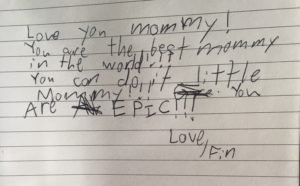
A note from my youngest son in the back of my journal. (He always calls me “Little Mommy,” and I always call him “Big Fin.”)
I missed random texting to/from friends, and to/from my parents and siblings.
I missed having navigation – and this also made me realize how lazy we have become as a result of it. Without Google Maps’ voice guiding me or telling me where to turn, how far to go before reaching my destination, etc., I had to pay attention to street signs and landmarks to find and remember my way. And, as if that wasn’t challenging enough for me, I had to use a (gasp) paper map handout to find my way to local trailheads. It’s been a long time since I’ve done that!
I missed listening to music. Not often, but on a few occasions, when I was writing, or driving to/from from my AirBnB to the workshop each day. I missed it for the energy it provides and the contemplations that particular music inspires in me. But I also came to realize that often I listen to music to perhaps “hide” from some of my thoughts, or to escape from some of the thoughts I’m having that I am not ready to confront, or that are uncomfortable. It was interesting to realize that listening to music can be a crutch for me sometimes. I will be more intentional when I listen to it now.
Interestingly, I wrote many of these insights during the last night of my technology ban. Just thinking about re-connecting to my iPhone and Facebook caused me some anxiety. I could actually feel tension in my shoulders and neck as I thought about it. I really wanted to be intentional about how I “re-entered” with my connectivity. I didn’t want to go from nothing to blowing it wide open again so suddenly. I was certain about not wanting to be as tethered to it as I was before the Silent retreat experience.
Upon re-entry, when I did log in to Facebook on my laptop, there were 82 notifications awaiting my attention.
It’s been almost two weeks since I re-connected with my iPhone and Facebook. I’m happy to report that I’m doing better. Not having the Facebook app on my iPhone has helped me limit the amount of time I’m on Facebook, and has made me more intentional (and “miserly”) about what I capture to eventually share. I am trying out a new strategy that involves batching and boundaries, and I feel hopeful!
Two things I want to close with that are related, and I am inspired to share with you…
When at LAX, waiting for my flight, and return to the Frontier of Wyoming, I had an hour to kill so I walked about 6,000 steps (thanks FitBit app) around the terminal. As I walked, I paid close attention to all of the people. I would about 8 or 9 out of 10 people, had cell phones and were looking down at their screens. (I did have a brainstorm during this observation: Think about how much fun it might be for you and your travel companion(s) to disperse in the airport and not be able to use your phone, and then try to find each other. Sort of like looking for Easter eggs only looking for travel partners in an airport without the use of cell phones)
Another idea: If you want to be different – to be a nonconformist – dare to not carry your phone around. You will definitely stand out!
The last thing I want to share is something wonderful and magical – and why it will be hard to convince myself ever to completely quit Facebook and social media.
Last Tuesday, on my drive from Ojai to Los Angeles, I stopped on the Pacific Crest Highway, to do a quick hike up to the top of Mugu Peak. At about 10:45am, right after starting, I asked a woman, who was coming down the trail, which trail I was on, and how to get to Mugu Peak. She was friendly and helpful, and told me about the two trails I could choose from, and she gave me approximate distances for each. That was it, no other information was exchanged, and no discussion ensued, and we were off in our opposite directions.
Then, I posted a photo the following Friday on Instagram (which is owned by Facebook) of the U.S. flag waving on the summit of Mugu Peak. Soon after, I received a comment on the photo from someone who indicated she was there about the same time that day because she recognized the misty, dramatic clouds that were obscuring the mountain in the background of the flag. I then responded and showed her another photo I had posted from the same hike of the orange poppies. She responded, asking where those were, saying she didn’t see those. I told her I captured the poppies photo on the alternative trail I took on the way down from the peak.
I then took a long shot and asked her if she was by chance the woman I stopped to ask about the trails leading to the mountain at about 10:45, and lo and behold, it was. Now, that’s crazy –and it is social media at its best and most magical. And it’s one of the reasons I’m in love with it.
I will be getting more clear on my next steps in confronting my tethered-ness and how to best continue my relationship with social media and my iPhone while not being as attached and tethered to them.
I have come to the conclusion that the iPhone and Facebook are not only not bad for me, they bring me great enrichment and joy for all of the reasons stated near the top of this blog post. Rather, my attachment and tethered-ness to them are.
As you can hopefully appreciate, this here is a tall mountain for me to climb. So tall that I cannot see the top. Articulating it here is a good first step, and at least, my journey is under way.
Thank you for reading, and for your support. I hope you’ll check back here often, or subscribe to this blog.
Related posts:
Falling in love with Ojai, California
——————————————————————————————————————————–
I am a certified life and leadership coach, personal development consultant, keynote (inspired) speaker, leadership development facilitator, adventure guide. I’ve coached 130 individual leaders from across the U.S. during the last 6 years. If you, or someone you know, would like to change your life and/or your leadership impact, I’d be honored to coach you. If you’re interested, please email me. I also bundle coaching with wellness and guided “Epic Adventure.” All of the adventures are “unplugged,” and offer you Solitude and space and time to be inspired and reflective.
- Categories: Adventure, Family, Fitness, Life and Leadership, Travel
- Tags: addiction, byron katie, ca, digitial detox, facebook, instagram, iphone, joe hollier, light phone, ojai, sherry turkle, silence, Silent retreat, social media, tethered
- Comments: 7 Comments

